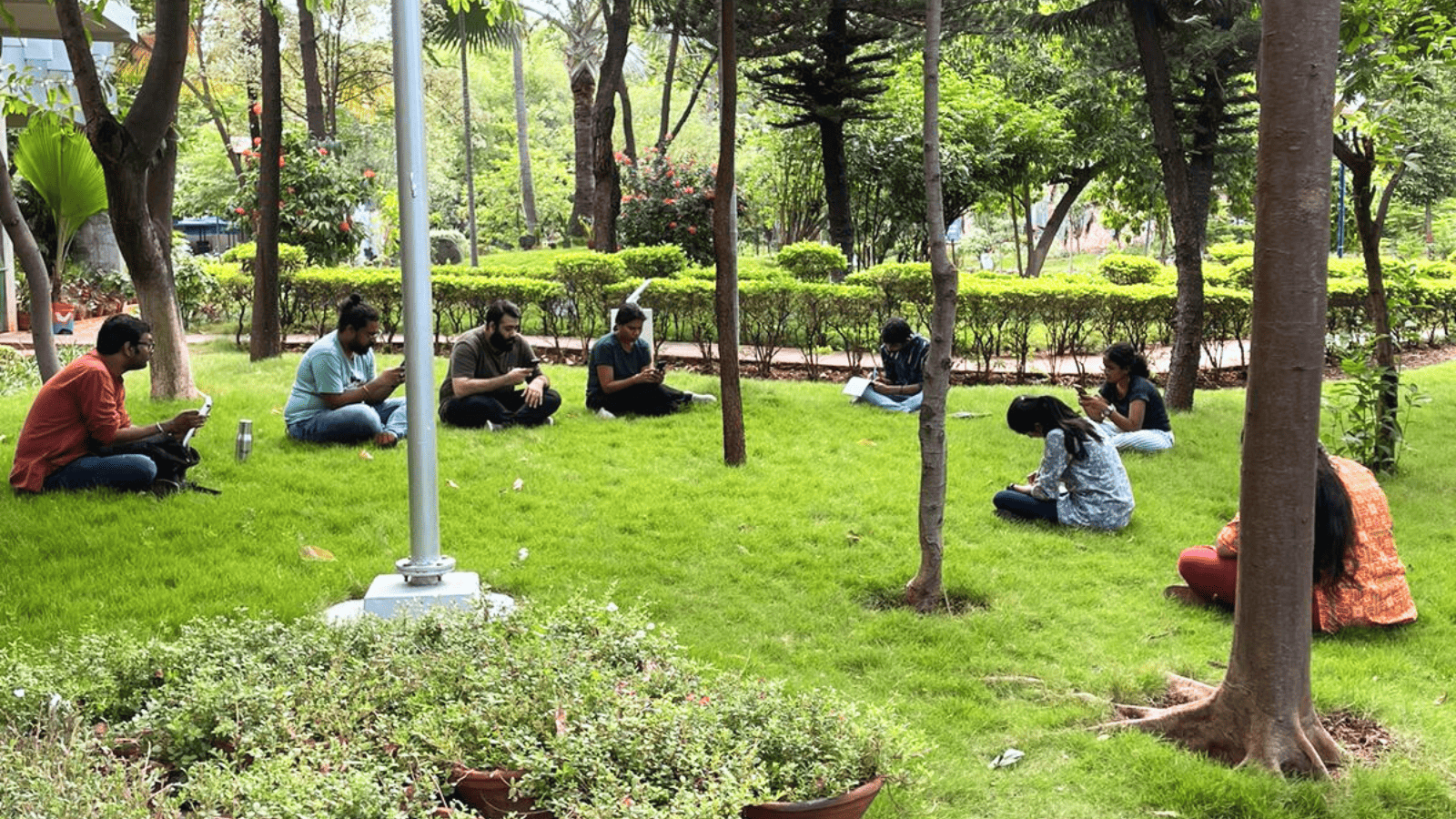“Pen Meets Petri Dish”: What happens when writers dive into the world of science? On July 1, 2023, this unique blend took place at the CCMB premises. It was an effort by Superheroes Against Superbugs (SaS), CSIR-CCMB and Write Club Hyderabad to blend two different fields.
The goal? Harnessing the art of writing to help people better understand Antimicrobial Resistance (AMR) and its complexities. But why focus on amateur writers? We wanted to connect with a group we usually don’t in science discussions. By joining hands with these writers, we hoped to simplify and share about AMR in a relatable way. By mixing science with storytelling, the event gave participants a fresh way to explore and share about AMR.
Bridging the Gap with Narratives
Transforming AMR and its intricacies into the mainstream presents a challenge that is real and pressing. Pushing the boundaries of AMR as a topic beyond the technical bubble and into the cultural narrative is essential to ensure to initiate dialogue at a larger scale and eradicate misconceptions around the subject. Case in point, Cancer. As a theme it has found its way into movies, making it a widely discussed and well understood topic while AMR remains tucked away in laboratories and seminar halls.
For us, this was the most significant gap we observed. Recognizing this void, the idea for ‘Pen Meets Petri Dish’ was born. The strategy? Engage with writers – those adept at shaping language to connect with a broad spectrum of readers. By doing so, we aspired translation of complexities in AMR into engaging stories, poems, and narratives. The mission was precise: harness the might of storytelling to demystify AMR, ensuring it’s not just understood but also incorporated in our everyday dialogue.
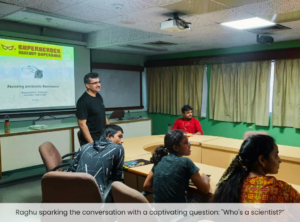
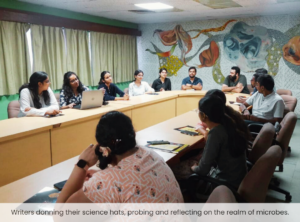
A Dive into AMR
The day at the CCMB premises began on a lively note as participants were warmly welcomed with SaS goodies. This not only set the mood for the day but also served as an instant ice-breaker.
Leading the event was Dr. Raghunand R Tirumalai, Principal Scientist at CCMB. The challenge he took on was simplifying and explaining Antimicrobial Resistance (AMR) for participants who weren’t from a life-sciences background. Ingeniously, Raghu initiated the dialogue by posing an intriguing question, “Who is a scientist?” He presented the audience with varied personalities – from historical figures like Mahatma Gandhi to icons like Dexter and eminent scientists like C.V. Raman. His intention wasn’t just to redefine the traditional image of a scientist but to set the stage for the day’s activities. By suggesting that a scientist isn’t solely someone in a lab coat pouring over research papers, but rather anyone who employs a systematic approach to understanding, he was subtly nudging the writers. He aimed to instill in them the belief that they too could employ scientific thinking in their narratives. This foundational idea was instrumental in shaping the event’s tone and priming the writers.
With this broader definition of a scientist in place, Raghu delved deeper into the core subject of AMR. He took the participants on a journey through its history, starting from its discovery by Alexander Fleming. He elucidated the mechanisms by which bacteria become resistant, touching upon topics like evolution, mutation, and the timeline of antibiotic resistance.
Following the insightful presentation by Raghu, the floor was opened to participants. What followed was sparking lively discussions and a volley of questions. Their curiosity was palpable. After this enlightening session, participants transitioned into a more hands-on experience. They embarked on lab tours where they got an up-close look at microbiological techniques. Observing bacterial cultures on petri plates, understanding the intricacies of laminar flow, and witnessing processes like electrophoresis offered them a tangible feel of the world of scientific research.
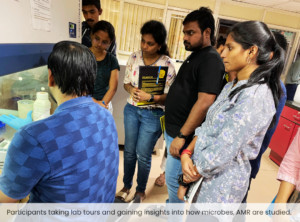
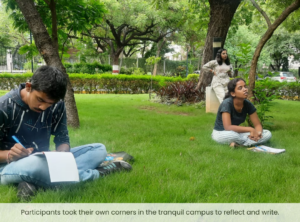
Channeling Science into Stories
After soaking in the facts and figures about AMR, it was time for participants to wear their writer’s hat. To kickstart this, a warm-up exercise was introduced, especially benefitting those unfamiliar with writing. This preliminary session was set amidst the lush greenery of the CCMB campus which presented an atmosphere of tranquility and inspiration. Participants split into small groups, engaged in the exercises, brainstorming sessions and penning down short blurbs.
Post the warm-up, they were encouraged to find their personal nooks within the wide green campus to reflect and write. Surrounded by nature, they settled into their chosen spots, allowing the beauty and serenity of the surroundings to fuel their creativity. Given an hour, they delved deep into their thoughts, crafting stories, poems, and narratives, all aimed at amplifying the significance of AMR through the power of words.
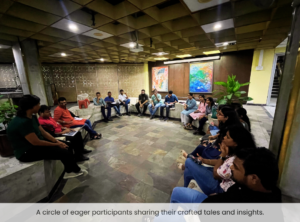
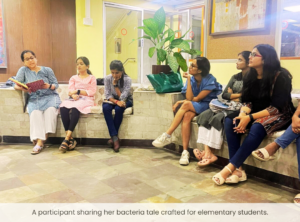
A Tapestry of Tales and Interpretations
To bring the event to a close, participants gathered in a circle, each eager to share their crafted tales and insights. The atmosphere was charged with anticipation and excitement as each individual unveiled their narrative, offering a window into their interpretation of the day’s learnings.
One participant captivated the group with a gripping story about the discovery of penicillin, leaving everyone at the edge of their seats with a suspenseful cliffhanger. Another delved into the intricacies of bacteria, discussing the horizontal transfer of genes and its role in producing increasingly resistant bacterial strains. The emotional weight of the day was palpable in a story narrated by a participant about a mother’s nightmare where her child contracts an AMR infection. This narrative delved deep into family dynamics, highlighting the skepticism of a husband who dismisses his wife’s genuine fears, only to confront the reality when their child falls ill. The session culminated with an innovative role-play, drawing parallels between AMR and real-life scenarios, underscoring the event’s central message.
Reflecting on the Journey and Looking Ahead
‘Pen Meets Petri Dish’ was more than just an event—it was an experiment, an exploration, and most of all, a collaborative endeavour. The blend of science with the art of storytelling offered a fresh perspective on addressing complex issues. Our key takeaway? The importance of simplicity. No matter how intricate a subject like AMR is, if it’s to be effectively communicated, it must be distilled into its most fundamental essence. The narratives crafted are only as compelling as the clarity of their underlying message.
Moreover, the event underscored the significance of hands-on activities and interactive games. Engaging participants in this manner ensures a deeper, more holistic understanding of the topic. It’s one thing to explain a concept, but another entirely to let participants indulge in it.
Lastly, this endeavour shone a light on the untapped potential of science fiction in our country. There’s a vast, unexplored territory here—a realm that can wield the dual power of entertainment and education. Science fiction, as seen through initiatives like this, can be a formidable tool in communicating challenging, yet imperative subjects.
In essence, ‘Pen Meets Petri Dish’ emphasises the need for more such initiatives—those that dare to break barriers, challenge norms, and, most importantly, inspire change.
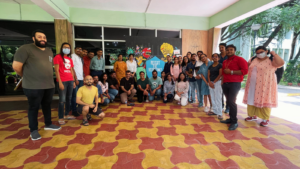
Acknowledgments: We extend our heartfelt gratitude to our generous funders, the Rockefeller Foundation and APSI-India, for invaluable support. We would also like to express our sincere appreciation to the dedicated organisers, Somdatta Karak and Aditya Undru, for their exceptional efforts in making this event possible. Special thanks go to our featured scientist, Dr. Raghu, his exceptional students for organising and conducting the lab tour and lastly, the writers of Write Club Hyderabad.
Explore the stories penned by a handful of participants! Stay tuned for more to come.
